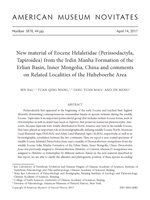Perissodactyls first appeared at the beginning of the early Eocene and reached their highest diversity, dominating contemporaneous mammalian faunas in species richness during the middle Eocene. Tapiroidea is an important perissodactyl group that includes earliest-Eocene forms, such as Orientolophus as well as extant taxa (such as Tapirus), that preserves numerous plesiomorphic characters. Because tapiroids were widely distributed in North America and Asia in the middle Eocene, they have played an important role in biostratigraphically defining middle Eocene North American Land Mammal Ages (NALMA) and Asian Land Mammal Ages (ALMA), respectively, as well as in biostratigraphic correlation between the two continents. Here we report a new cranial specimen of middle Eocene helaletid Paracolodon fissus and a maxilla of Desmatotherium mongoliense from the middle Eocene Irdin Manha Formation of the Erlian Basin, Inner Mongolia, China. Paracolodon fissus was previously assigned to Desmatotherium, Helaletes, or Colodon, whereas D. mongoliense was assigned to Helaletes or Irdinolophus by different authors. Based on the new material described in this report, we are able to clarify the affinities and phylogenetic position of these species according to morphological comparison and phylogenetic analyses. We maintain the genus Paracolodon for P. inceptus and P. fissus from Asia and reassign mongoliense to Desmatotherium. Fossils of perissodactyls and other groups from the Irdin Manha Formation favor correlation of the Irdinmanhan ALMA with the early and middle Uintan NALMA (Ui1-Ui2). Through our field investigation, we also clarified that the localities “7 miles southwest” and “10 miles southwest” of Camp Margetts, originally used by the American Museum of Natural History's Central Asiatic Expedition (CAE), correspond to the localities currently known as Huheboerhe and Changanboerhe, respectively.
How to translate text using browser tools
14 April 2017
New Material of Eocene Helaletidae (Perissodactyla, Tapiroidea) from the Irdin Manha Formation of the Erlian Basin, Inner Mongolia, China and Comments on Related Localities of the Huheboerhe Area
Bin Bai,
Yuan-Qing Wang,
Fang-Yuan Mao,
Jin Meng






